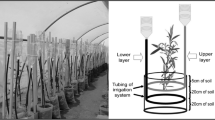Abstract
The growth characteristics of threeRumex species were determined under different solution oxygen concentrations in hydroculture. These species all occur in a river foreland ecosystem and they were found to differ in their flood tolerance. The flood-tolerantR. maritimus undR. crispus developed a large number of new, aerenchymatous roots within a short period under low solution oxygen concentrations. Biomass production was not affected. In the flood-intolerantR. thyrsiflorus, however, only few slow-growing new roots were developed and biomass production was significantly reduced at solution oxygen concentrations below 2% (v:v). These different responses could be partly explained by a differential aerenchyma formation in new roots of the flood-tolerant species. Aerenchyma can relieve the oxygen stress of the root systems via internal aeration.
The fast development of new roots of the flood-tolerantR. maritimus andR. crispus after the onset of anaerobiosis coincided with the reduction or cessation of growth of the primary roots. Notwithstanding the cessation of growth, however, primary roots of both species were able to recover following restoration of aerobic conditions after a 13-day anaerobic period. However, the roots ofR. thyrsiflorus ceased growing very soon after the onset of anaerobiosis. All had died within 10 days.
The balance between the growth rates of the primary and the newly formed root system are discussed and related to the differential tolerance of theRumex species to transient flooding.
Similar content being viewed by others
References
Armstrong W 1979 Aeration in higher plants. Adv. Bot. Res. 7, 225–332.
Armstrong W and Webb T 1985 A critical oxygen pressure for root extension in rice. J. Exp. Bot. 36, 1573–1582.
Blom C W P M, Bögemann G M, Laan P, Van der Sman A J M, Van de Steeg H M and Voesenek L A C J 1990 Adaptations to flooding in plants from river areas. Aquatic Botany 38, 29–47.
Buwalda F, Barrett-Lennard E G, Greenway H and Davies D A 1988 Effects of growing wheat in hypoxic nutrient solutions and of subsequent transfer to aerated solutions. II. Concentrations and uptake of nutrients and sodium in shoots and roots. Aust. J. Plant Phys. 15, 599–612.
DeDatta S C 1985 Simultaneous and intermittent measurement of K, Ca and NO3-ion absorption by intact bean plant (Phaseolus vulgaris L.) in aerobic and anaerobic condition. Plant and Soil 84, 193–199.
Drew M C and Sisworo E J 1979 The development of waterlogging damage to young barley plants in relation to plant nutrient status and changes in soil properties. New Phytol. 82, 301–314.
Hoagland D R and Arnon D I 1950 The waterculture method for growing plants without soil. Circ. Calif. Agricult. Exptl. Station 347. University of California, Berkeley.
John C D, Limpinuntana V and Greenway H 1974 Adaptation of rice to anaerobiosis. Aust. J. Plant Physiol. 1, 513–520.
Laan P, Berrevoets M J, Lythe S, Armstrong W and Blom C W P M 1989a Root morphology and aerenchyma formation as indicators of the flood-tolerance ofRumex species. J. Ecol. 77, 693–703.
Laan P, Smolders A, Blom C W P M and Armstrong W 1989b The relative roles of internal aeration, radial oxygen losses, iron exclusion and nutrient balances in flood-tolerance ofRumex species. Acta Bot. Neerl. 38, 131–145.
Laan P and Blom C W P M 1990 Growth and survival responses ofRumex species to flooded and submerged conditions: The importance of shoot elongation, underwater photosynthesis and reserve carbohydrates. J. Exp. Bot. 41, 775–783.
Laan P, Tosserams M, Blom C W P M and Ween B W 1990 Internal oxygen transport inRumex species and its significance for respiration under hypoxic conditions. Plant and Soil 122, 39–46.
Laan P, Tosserams M, Huys P and Bienfait H F 1991 Oxygen uptake by roots ofRumex species at different resistance and enzyme kinetics. Plant, Cell Environ. 14.
Railton I D and Reid D M 1973 Effects of benzaldehyde on the growth of waterlogged tomato plants. Planta 111, 261–266.
Thomson C J, Atwell B J and Greenway H 1989 Response of wheat seedlings to low O2 concentrations in nutrient solution. II. K+/Na+ selectivity of root tissues of different age. J. Exp. Bot. 40, 993–999.
Trought M C T and Drew M C 1980a The development of waterlogging damage in young wheat plants in anaerobic solution cultures. J. Exp. Bot. 31, 1573–1585.
Trought M C T and Drew M C 1980b The development of waterlogging damage in wheat seedlings (Triticum aestivum L.). II. Accumulation and redistribution of nutrients by the shoot. Plant and Soil 56, 187–199.
Author information
Authors and Affiliations
Rights and permissions
About this article
Cite this article
Laan, P., Clement, J.M.A.M. & Blom, C.W.P.M. Growth and development ofRumex roots as affected by hypoxic and anoxic conditions. Plant Soil 136, 145–151 (1991). https://doi.org/10.1007/BF02150045
Received:
Revised:
Issue Date:
DOI: https://doi.org/10.1007/BF02150045




